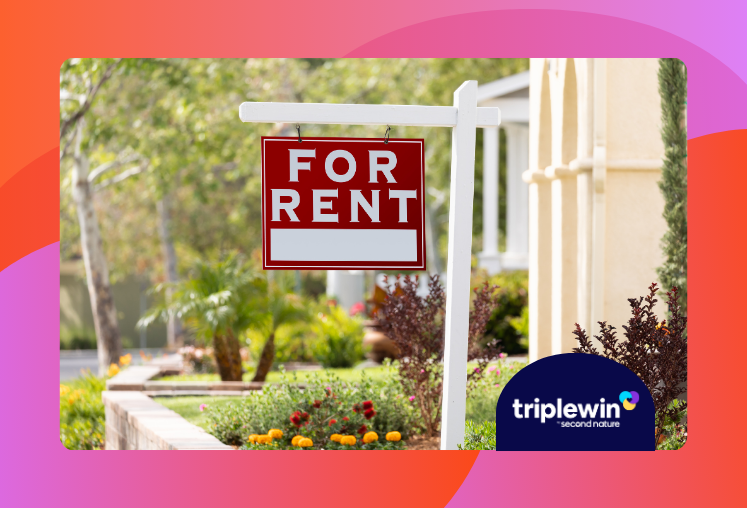Jennifer Ruelens is the broker/owner at One Focus Property Management, the largest property management company in North Central Pennsylvania. Jennifer has over twenty years of real estate experience, and 13 as broker/owner at One Focus. She also founded Hold It with PM Jen, a platform dedicated to helping investors grow wealth with the buy and hold real estate strategy. Jen is a Second Nature Triple Win Mentor.
Hot take: resident selection is the single most important thing you do as a property manager. It doesn’t just make your life easier, it drives performance and maximizes income.
There’s a very real temptation to fill vacancies as quickly as possible, minimize the time that a unit sits empty, and get back to earning management fees. But if you want to grow and mature as a property manager, you need to resist that temptation. Instead, you need to be selective about who you accept, using a clear, standardized process.
When you pick the right residents, you can generate more revenue in the long term because you have fewer disputes, fewer issues, less delinquency, and higher renewal rates
Your greatest liability isn’t the property, it’s the person in it
There are three main sources of risk in real estate:
- Market risk: Think about the economy, job market, interest rates, etc. These will impact pricing, the number of applicants you get, and whether investors are buying or selling homes. The thing is, you can’t really do anything about. (Trust me, if I could magically change the global economy, I wouldn’t be writing blog posts right now.) You just have to accept them and stay aware of them.
- Asset risk: This is the risk associated with the physical property itself. Is it going to burn down? Is the boiler going to go out? Is a storm going to rip the roof off? We mitigate this risk by scheduling regular inspections, doing preventative maintenance, and carrying sufficient insurance.

- Resident risk: This is the risk that comes from your choice of resident and their behavior once they’ve signed a lease. Will they pay the rent, will they damage the property, will they sue you? That is just the tip of the iceberg. This is your largest source of risk and the only one that you have 100% control over. The thing about resident risk is that it’s inherently complex, yet you only get the decision on who you rent to when you (a) have a vacancy, or (b) choose whether to renew a lease.
My philosophy is that If we can obsessively focus on our acceptance and renewal decisions, we can have a real impact on the business, but most companies aren’t making it a priority. Typically, property managers are accepting the first vaguely qualified applicant they get, and then renewing that lease at every opportunity unless something truly awful happens. Instead, we should be using verifiable, objective data to look at how residents are performing and what they’re costing us in time and energy, then making renewal decisions based on that.
As always, every market and portfolio is different. I’m not going to be prescriptive about exactly how you should be making acceptance and renewal decisions, because it depends on the product you’re offering and the community you’re serving, but it should be backed by concrete metrics.
The main thing is that you never want to be in a spot where you’re stuck with a resident because you renewed them when you shouldn’t have. You should be as deliberate about renewal decisions as you are about applications.
Draw the line early, and watch the wrong applicants walk away
Another hot take: If an applicant is “ghosting you” midway through the process, they’re not actually ghosting you; they’re actually just self-selecting out. And that’s a good thing.
Self-selecting out of the process just means that the applicant realized it wasn’t a fit, or that you were probably going to decline them anyway. People opting to drop out of the process is actually a sign that you’re communicating your expectations and your process well. Applicants have digested that information and decided you’re not the right fit for them (and that means they probably weren’t going to be the right fit for you, either).
When you’re trying to find residents to fill your vacancies, you basically have two main things that applicants are looking at: your product—what the property is—and your process—how you manage it and make decisions around it. You need to align on both in order to find a good fit.
Your rental isn’t “just a rental.” It’s your reputation.
The product you’re marketing is the property itself; the home someone’s going to rent from you. The quality of that product and how you present it are a direct reflection of your company. If you’re showing a property that’s not in excellent condition, clean, and ready to be shown, residents are going to assume that they’ll have a chaotic, less-than-stellar experience living there.
If it’s well maintained, clean, and neat, that communicates that you’re on top of things. It shows that you care about the quality you’re delivering, and that you never treat a property as “just a rental” (which, by the way, is one of my least favorite phrases on earth).
The process sets the terms of the relationship
The process behind the product is how you run your business. How you approach maintenance, resident relationships, inspections, late payments… that’s all process.
The application and leasing process is about filling a vacancy, yes, but it’s about telling the resident what to expect. When we work with a renter through the application process, we’re showing them that we’re going to be communicative and helpful, we’re not going to leave them high and dry, and we’re going to meet every obligation we have. We’re going to do it professionally, expertly, quickly, and friendly.
At the same time, we’re communicating that the resident has obligations they’re agreeing to, and we’re going to hold them accountable to those. We’re illustrating what those obligations are, and that we’re not going to accept people who want to duck those responsibilities. In a way, this is where we’re giving them the opportunity to self-select out. If they aren’t ready for those expectations, this isn’t going to work. We’re not trying to scare them away, but we’re also trying to be honest and transparent about who we are and how we work.
So how do we set that expectation? We start at the listing. Each of our rental listings includes a thorough description of both the property and our process, which aims to answer as many of their questions as possible. We want to outline our expectations to a T so that only those renters who are going to be a good fit actually apply.
Part of that clarity includes describing our onboarding process, too. Moving is almost never fun for residents, so when you’re thinking about your onboarding process, you want to be there to support them, but you also need to set clear expectations.
At OneFocus, we’re very upfront that we do a video move-in inspection. That’s often a 20-25 minute video where we walk through the home, open every cabinet and drawer, and document everything. We also ask the resident to do exactly the same thing so that we can clear up any inconsistencies. When we tell residents about this, it lets them know that we’re not a management company that plays fast and loose with security deposits. We don’t make exceptions and we don’t let things slide.
How the applicant responds to that is very telling. It shows us who they’re going to be as a resident. Their cooperativeness throughout the application process is the only subjective piece of our application process. If they’re abusive, rude, unresponsive, and difficult to work with, that’s going to work against them.
When I say that, I don’t mean just asking questions or getting clarification on how to go about the process. I actually really like residents who have a lot of questions for me about how I run my business. That’s not a nuisance, it’s a sign that they’re aligned with my expectations, they’re going to be a good fit, they’re proactive, and they’re communicative. They’re as invested in finding the right fit as I am.
When I talk about difficult applicants, I’m talking about people who are repeatedly dialing, calling over and over and refusing to leave a voicemail. I’m talking about any kind of abusive language, yelling at my staff, or otherwise treating us poorly. I’m talking about repeatedly no-showing appointments that they’ve made and disrespecting our time. Those are all red flags that show us we probably don’t want to commit to working with this person for a year or more.
Bend the rules today, pay for it tomorrow
Building and sticking to a comprehensive process takes time, but it takes even more discipline. There’s a lot of pressure to fill vacancies quickly, both from your investor clients and internally.
The thing is, over the years, I have deviated from my process, and every single time I’ve ended up paying for it later. At this point in my career, if a client asked me to do them a favor that circumvented my process, there’s a decent chance that client is getting fired. I don’t break from my process, and my clients know that.
It’s never worth breaking the process just to fill a spot. If you’re struggling to find qualified applicants, yes, you can make some changes; revisit how you’re presenting the process, revisit your pricing, but don’t lower your standards and accept a resident who’s going to cause problems down the line. It’s not only a potential fair housing violation to deviate from your published process, it’s also just bad business.
If the process fails, fix it—don’t abandon it
If a resident gets through applying, selection, and my onboarding with me, they have no reason to be surprised with how I manage the property and what I expect from them. That’s the goal of a robust process. If you’re finding that your residents aren’t aligned with your expectations, it’s time to strengthen the process.
It’s worth stating that you don’t strengthen your process by just updating your lease. Old-school managers tend to just add another addendum to the lease to cover whatever stupid thing the last resident did (and some of those addenda aren’t even legally enforceable). The best property managers will look deeper, make their process more thorough, and actually drive business improvements.
Want to see how you can appeal to more financially responsible residents with benefits like credit reporting and identity theft protection? Request an RBP demo with a local expert today.




